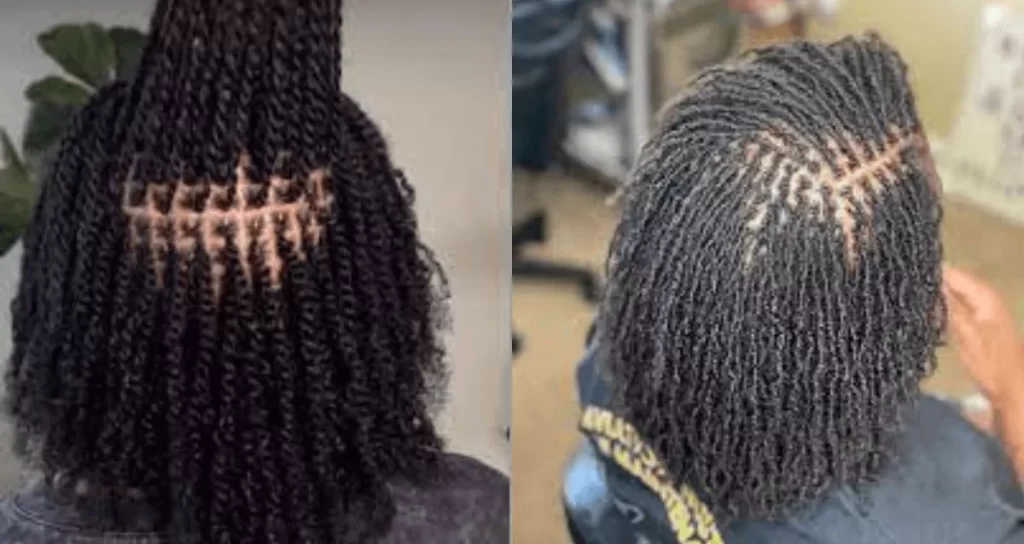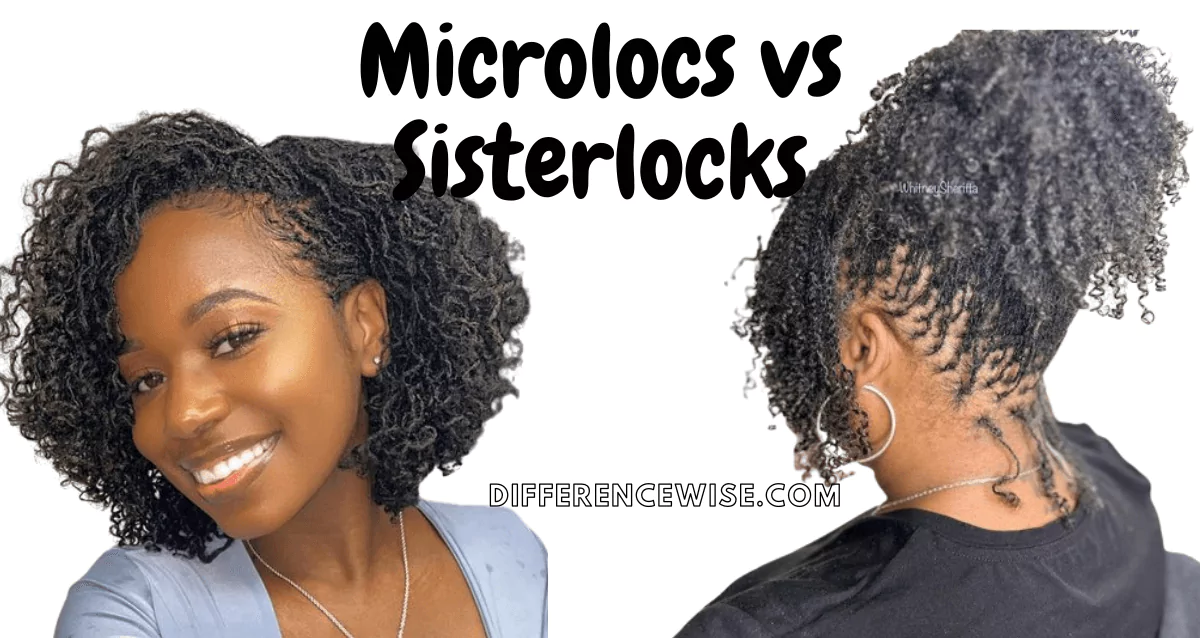In the world of natural hair, the decision between Microlocs and Sisterlocks often leaves many in difficulty. These two charming yet similar hairstyles are so popular among the African-American community for their low maintenance. But what has taken Microlocs vs Sisterlocks to a competition? It’s indeed their installation techniques, grinding pattern expenses, and a lot about suitability. Just stay by my side to know the nitty-gritty details about the origin, maintenance tips, and pros and cons of both hairstyles.
History and Origin of Microlocs vs Sisterlocks
Microlocs and Sisterlocks are modern hairstyles that have changed how people with curly or textured hair style and care for their hair. However, they both carry different backgrounds and stories behind them. For a second if we talk about Microlocs then they are installed as small locs that people make using different methods like braiding, interlocking, or twisting. We can see their widespread popularity which seems to be because they’re flexible to style and work for different hair types and lengths.
On the flip side, Sisterlocks have a more defined origin invented by a loctician Dr. JoAnne Cornwell in 1993. She wanted to make a way for women to manage their natural hair without chemicals or heat. Sisterlocks are made using a special grid and tool to create small, neat locs. Only trained consultants can do Sisterlocks because the technique is patented.
Overview of Microlocs
Microlocs are a hairstyle where small sections of hair are twisted into locks. They’re smaller than regular dreadlocks and can be styled in many ways. People with different hair types and lengths like them because they’re versatile and work well for textured hair. Moreover, they are easy to install without consulting any professional. Microlocs can be done through the below ways even at home.
- Braiding
Braiding is one of the methods used to start Microlocs. In this method, small sections of hair are braided to start the locking process. Over time, as the hair grows out, it begins to mat and lock on its own. It is often chosen for its simplicity and because it allows for a neat appearance of the locs from the start.
- Interlocking
This method uses a tool to tie the end of the hair to the root, making a knot to keep it in place. It’s good for people with soft hair that struggles to hold twists or braids. With interlocking, you can wash and care for your locs right after making them, which isn’t always possible with other methods.
- Twisting
In this popular method, you can begin by twisting small sections of hair using a comb or your hands to start the locking process. As time passes, the twists become matted and form Microlocs.
Overview of Sisterlocks
Sisterlocks are a way for women with tightly curled hair to welcome their natural texture. They create small, even locks using a special grid and tool, letting women style their hair in different ways. Sisterlocks are created using a specific parting grid and a special tool to create uniform, small locs. The installation process is meticulous and requires a certified Sisterlocks consultant. The consultant will use a specific tool to weave your hair into small, consistent locs.

Microlocs vs Sisterlocks: How do they both differentiate?
- Installation and Maintenance Cost
You can get Microlocs installed for a cost between $200 to $600. It completely depends on your hair length and the experience of the stylist. However, maintenance is cheaper as it can be maintained at home once you learn the technique. Usually, it costs $50 to $80, which is affordable.
For Sisterlocks, installation is pricier, ranging from $400 to $1,000 due to the specialized technique and needing a certified consultant. Its maintenance is also higher, costing $100 to $200 every 4-8 weeks for retightening by a certified consultant.
- Grid Pattern
The grid pattern for Microlocs is not as strict or uniform. The size and spacing of the locs can be adjusted based on personal preference.
Sisterlocks uses a precise parting grid to ensure uniformity and neatness. This grid pattern is a key characteristic of Sisterlocks.
- Installation Technique
Microlocs can be started with various techniques such as braiding, interlocking, or twisting. Whereas, Sisterlocks are installed using a specific tool and technique. The hair is not braided or twisted, but rather woven into small, uniform locs.
- Installation Time
The installation time for Microlocs can vary greatly depending on the chosen method and the individual’s hair length and density. But on average 36 hours are estimated. The installation of Sisterlocks is a lengthy process that can take two or more sessions of several hours (8 to 20 hours) each. The exact time can vary based on hair length and density.
- Maintenance
Microlocs require regular washing and retightening every 4-6 weeks. The frequency of maintenance can vary based on hair growth and personal preference. Sisterlocks also demand regular retightening sessions with a certified consultant. The use of heavy oils, creams, or butter is discouraged as these can cause buildup in the locs
- Suitability
Microlocs are versatile and can be suitable for various hair types and lengths. Sisterlocks can also be suitable for different hair types and lengths. However, they are often preferred by individuals with tightly textured hair.
Pros and Cons of Microlocs vs Sisterlocks
| Microlocs | Sisterlocks | |
| Pros | 1- Microlocs can be styled in numerous ways due to their small size and flexibility. 2- They can be created on various hair types and lengths and make you look stylish throughout the year. 3- The cost of installing and maintaining Microlocs is generally lower than Sisterlocks.4- Once you learn the technique, Microlocs can be maintained at home. | 1- Sisterlocks are created using a specific parting grid and a special tool, resulting in a neat, uniform appearance. 2- Once installed, Sisterlocks are relatively low maintenance.3- Sisterlocks do not require the use of harsh chemicals or heat, making them a healthy choice for your hair. |
| Cons | 1- The installation process for Microlocs can be quite time-consuming, especially for longer or denser hair. 2- Microlocs require regular washing and retightening, which can be time-consuming. | 1- The installation and maintenance of Sisterlocks are typically more expensive due to the specialized technique. 2- Maintenance requires regular visits to a certified consultant for re-tightening. |
Tips to Maintain Your Locs
On average, there are 400 to 1,000 locs each individual has, which raises the demand for a careful routine. Below are some tips to keep the Microlocs and Sisterlocks healthy and beautiful.
- Depending on your lifestyle and scalp, you may need to wash your locs anywhere from once a week to once a month.
- Make sure your locs are completely dry before styling or going to bed to prevent mildew or a musty smell.
- Keep your scalp clean and well-moisturized.
- Protect your locs at night by covering them with a silk or satin scarf or bonnet. This reduces friction and helps to maintain moisture.
Choose Microlocs if:
- You prefer versatility.
- You have different hair types and lengths.
- You are budget-conscious.
- You prefer DIY maintenance.
Choose Sisterlocks if:
- You prefer low maintenance.
- You prefer a unique and uniform appearance.
- You value natural and healthy hair management.
FAQs
It depends on personal preference and hair type.
Microlocs can be time-consuming to install and maintain.
Wrapping Up
We have gone through the thrilling pros and cons of Microlocs vs Sisterlocks along with their way of installation. You can choose one of them on your personal preferences, keeping in view your lifestyle, budget, and, hair type. You can go for Microlocs if you are having financial issues. Otherwise, consult with experts and go for Sisterlocks.

